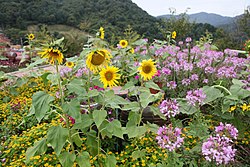Pocheon Korea: Difference between revisions
Created page with "{{Infobox municipality |municipality= City |established = 1413 |image = Korea-Pocheon-Herb Island-Sunflower an others-01.jpg |image_caption = A flower field in the Herb Island..." |
No edit summary |
||
| Line 1: | Line 1: | ||
{{Infobox municipality | {{Infobox municipality | ||
|image=Korea-Pocheon-Herb Island-Sunflower an others-01.jpg | |||
|image_caption=A flower field in the Herb Island in Pocheon | |||
|image = Korea-Pocheon-Herb Island-Sunflower an others-01.jpg | |image_seal=Pocheon logo.jpg | ||
|image_caption = A flower field in the Herb Island in Pocheon | |municipality=City | ||
|image_seal = Pocheon logo.jpg | |established=1413 | ||
|area = 513.55 sq.mi | |area=513.55 sq.mi | ||
|elevation = 2785 ft | |elevation=2785 ft | ||
|population = 160176 | |population=160176 | ||
|timezone=UTC+9 | |||
|timezone = | |description=Pocheon is an inland city in the far northeastern region of Gyeonggi province in South Korea. It covers 826.48 km (513.55 mi)2 with a population of 160,176 people, according to the 2008 census. Pocheon lies between Seoul and the mountainous northwestern areas of Gangwon province. The city borders Yeoncheon county, with the cities of Dongducheon and Yangju to the west, along with Uijeongbu, and Namyangju of Gyeonggi province to the south. It also borders Hwacheon county of Gangwon province on its eastern border and Cheorwon is to the north. Alongside the adjoining Gapyeong, Pocheon consists of the highest mountainous areas in Gyeonggi province. The current city of Pocheon was created after Pocheon-hyeon and Yeongpyeong counties were merged. The north part of the city used to be part of Yeongpyeong county while the south used to be part of Pocheon-hyeon. | ||
|description= | |||
Pocheon is an inland city in the far northeastern region of Gyeonggi province in South Korea. It covers 826.48 km (513.55 mi)2 with a population of 160,176 people, according to the 2008 census. Pocheon lies between Seoul and the mountainous northwestern areas of Gangwon province. The city borders Yeoncheon county, with the cities of Dongducheon and Yangju to the west, along with Uijeongbu, and Namyangju of Gyeonggi province to the south. It also borders Hwacheon county of Gangwon province on its eastern border and Cheorwon is to the north. Alongside the adjoining Gapyeong, Pocheon consists of the highest mountainous areas in Gyeonggi province. The current city of Pocheon was created after Pocheon-hyeon and Yeongpyeong counties were merged. The north part of the city used to be part of Yeongpyeong county while the south used to be part of Pocheon-hyeon. | |||
}} | }} | ||
Revision as of 06:45, March 26, 2022
| Pocheon Korea | |
|---|---|
 | |
| A flower field in the Herb Island in Pocheon | |
| Seal | |
| Pocheon Korea Map | |
| Type of Municipality | City |
| Date Established | 1413 |
| Area | 513.55 sq.mi1,330.089 sq.km <br />328,672 Acres <br />1,330,089,364.5 sq.meter <br />14,317,774,000 sq.ft <br /> |
| Elevation | 2785 ft848.868 m <br /> |
| Population | 160176160,176 people <br /> |
| Timezone | UTC+9 |
- Members
Pocheon is an inland city in the far northeastern region of Gyeonggi province in South Korea. It covers 826.48 km (513.55 mi)2 with a population of 160,176 people, according to the 2008 census. Pocheon lies between Seoul and the mountainous northwestern areas of Gangwon province. The city borders Yeoncheon county, with the cities of Dongducheon and Yangju to the west, along with Uijeongbu, and Namyangju of Gyeonggi province to the south. It also borders Hwacheon county of Gangwon province on its eastern border and Cheorwon is to the north. Alongside the adjoining Gapyeong, Pocheon consists of the highest mountainous areas in Gyeonggi province. The current city of Pocheon was created after Pocheon-hyeon and Yeongpyeong counties were merged. The north part of the city used to be part of Yeongpyeong county while the south used to be part of Pocheon-hyeon.
Activities

|
GO-PS Gyeonggi Open Platform for SmartCity | |
| GO⋅PS is a smart city standard platform to utilize the element technology of the age of 4th Industrial Revolution as a means to solve urban problems.
The Gyeonggi Province of Korea, along with Gyeonggi Research Institute (GRI) and Gyeonggido Business and Science Accelerator (GBSA), is currently creating and operating an industry-academia-related consultative body to create a sustainable business model. GO⋅PS matches companies, research institutes, and academics according to the demand of public urban matters, and uses its technologies, research works, and consulting methods to create solutions for problems and have them collected on the platform. The GO・PS is currently comprised of three large departments namely, Smart Transport, Smart Energy, and Smart Healthcare. (It is planned to be expanded with more departments in the future) | ||